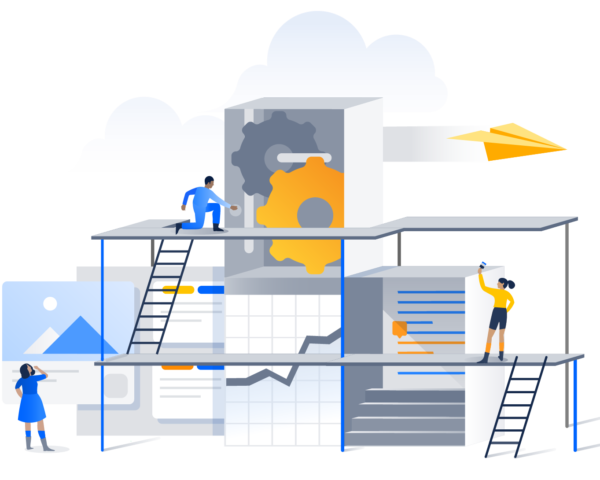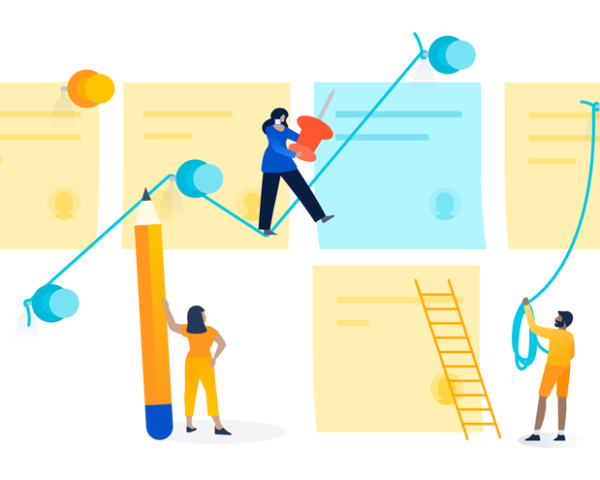Managing the development of a new product from the ground up is never easy. Doing so with several teams from different departments or companies, who each have their own culture and toolset, makes it even harder. And when one person is responsible for facilitating the process, you’ve got a perfect storm of complexity.
Sound familiar? Our condolences. Shawn Adams has felt your pain, and he’s got wisdom to share.
As a Release Train Engineer (RTE) with experience engineering firm PK, Adams brought together 150 people from eight companies (including AT&T, Verizon, and T Mobile/Sprint) to create Zenkey, the first multi-factor authentication app that uses wireless phone carrier data to verify identity instead of SMS.
Getting the three largest telecommunication companies to work together and deliver an effective solution that met everyone’s needs (especially those of their users) required empathetic yet assertive leadership, supported by flexible and collaborative technology.
Adams rose to the challenge on both fronts. He learned how to turn competitors into collaborators, keep everyone in sync from high-level strategy to technical execution, and make faster, better decisions – all with the help of Jira Align. Along the way, he kicked his agile leadership skills up a notch and picked up practical tips that enabled him – and anyone else carrying the weight of complex enterprise projects – to guide their teams and products to success.
Stay focused on the “why”
PK had been going through their own agile transformation and adapting their own Scaled Agile Framework (SAFe), so when one of the telecom carriers involved in Zenkey’s development asked Adams if they could use this approach for Zenkey, he was primed to put those principles into practice.
Agile encourages team empowerment and self-management. It also demands collaboration and transparency – difficult values to live by when you’re working with staunch competitors who each keep their practices, systems, and data under lock and key. For example, AT&T, Verizon, and T-Mobile each had their own instances of Atlassian software and individual teams who broke down stories for development. Plus, in order for Zenkey to work properly, each carrier needed to share seconds-old mobile data to verify a user’s identity. To overcome these obstacles and ensure Zenkey delivers on its promises, Adams had to find a way to turn competitors into colleagues.
Adams’s partner at Atlassian, Enterprise Solutions Architect Rob Phillips, anticipated these issues and encouraged Adams to continue reiterating the importance of trust and teamwork. Phillips says, “The purpose of using agile practices is to create alignment and orchestration across many independent groups. When you’re working collaboratively to build a product that is the composite of these different groups, it’s the RTE’s job to help everyone come together as a team to create a great product.”
To chip away at the barriers between the telecom carriers, Adams regularly brought key players and stakeholders into the same room and aligned everyone around their shared goals. “I would tell them, ‘We’re here to make Zenkey work, not steal anyone’s secrets. Our goal is to deliver functionality and do whatever it takes to make that easy,’” he recalls. “We stayed focused on the ‘why’ and set the expectation that we’re going to be transparent as a group, but it’s okay to say you aren’t comfortable talking about something.”
The carriers were especially concerned about keeping certain data and stories confidential, so Adams set up Jira Align, Jira Software, and Confluence so that all teams could see epics, but couldn’t see each other’s individual stories. “This helps keep their ‘secret sauce’ secret. There isn’t any super aggregated data, and walls are maintained for privacy. If all we want is to change the button from green to blue, each carrier does what they need to do for that functionality,” he explains.
As everyone saw how working together led to better results without sacrificing confidentiality, the momentum picked up. “Because you have competitors collaborating, everyone was a little on edge. But once we learned to focus on the ‘why’ and have open conversations, it sped up the process,” Adams says.
He shares an example: “Whenever I got everyone together, I just kept reiterating that our goal was to help people easily maintain security,” Adams recalls. “This helped save time in many ways, like resolving defects faster. We used to have one common defect meeting, then individual meetings with each company. We realized we were having the same conversations and facing the same issues with slightly different variations. After six months, we were finally able to talk about defects with vendors present, connect the dots that everyone was having similar issues, and groom features better.”
As walls came down, noticeable improvements started cropping up. In addition to reducing the amount of time spent on duplicative work, collaborating and sharing non-confidential information helped decrease the percentage of severe defects from about 30 percent to the low teens. Adams adds, “With so much complexity in this project, we knew low velocity was a risk. It was important to see feature release progress increasing over time. With Jira Align keeping all the teams on the same page, we saw feature acceptance increase by over 50 percent.”
Create a common language and set of tools
Much like bringing people together from different countries, working with stakeholders from different companies means finding a way to speak the same language, even if it’s not your native tongue. Adams accomplished this goal with open communication and Jira Align.
“We came together from different corporate cultures and had to learn to get more specific with our actions, like how to do a kanban board the same way,” he says. “It helps to have a common set of tools in one place where everyone can see the same thing, organize our activities, and plan execution together.”
As the teams worked together more, Adams also noticed that each one called the same concepts by different names. To save time and reduce confusion, he leveraged the common vocabulary of a scaling framework to standardize everyone’s understanding of epics and features, for example. As he came across other terms that had different meanings to different people, he built a glossary within Jira Align and socialized each name and definition with the team.
Phillips adds, “If you’re dealing with a lot of diversity, Jira Align can be a hinge that helps create a homogenous understanding of agile and a common approach.”
Centralize people and information in real time
When you’re using disparate tools to track work and dependencies, it’s difficult – if not impossible – for everyone to see what’s happening, make informed decisions in real time, or work together at scale.
By using Jira Align to track dependencies and bring each carrier’s separate backlog into one portfolio backlog for refinement, Adams and the team finally gained visibility into all the information they needed in one place and had better conversations with each other, leading to faster, better progress.

“One of our big milestones was executing planning using just Jira Align. We did all our refinement and prioritization in the tool,” Adams says. “Being able to use it to have conversations in real time with real data is powerful. No need to go back and check spreadsheets!”
Zenkey’s distributed teams were even more thankful for a solution that supports remote work. Having a central platform has helped everyone stay on the same page and work just as quickly while doing all meetings, planning, and collaborative work online with Jira Align.
Adams says using Confluence for agendas, step-by-step guides, and other documentation also made it easier to record and share knowledge. “[Confluence] makes training or teaching someone much easier because we can say, ’Here’s the agenda and a link to the steps we’re going to go through. You can go through it on your own afterward.’”
Centralizing work and making it more visible not only sped up the development process, but also underscored the open culture Adams was striving for, so the team could continue making progress at scale.
As they worked their way through such a large, complex project, Adams started each new phase taking small steps into new functionality with the teams. For example, he tested out a lightweight solution for tracking dependencies in Jira Align then worked up to more mature functionality. Adams used Jira Align’s work item links as a simple way to manage commitments and formalize delivery. He later used dependency items to allow for close tracking of the complexity of the work.
He also used backlogs, prioritization, and roadmap views initially before advancing into kanbans and program boards. In the future, he may progress into portfolio rooms and strategy rooms. This “crawl, walk, run” approach helps everyone gain familiarity with each feature and get the most value out of it before graduating to the next level.
Seek out a sounding board for support
Adams says guidance from Rob Phillips and Tim Keyes, who served as PK’s Technical Support Lead at Atlassian, has been invaluable throughout Zenkey’s development process. “Rob and Tim have been great partners – available and competent. Even if I had a simple question like, ’What should this work structure look like?’ I could go to Rob for advice, and he could share what he’s seeing other teams do. We’ve grown into better practices with his and Tim’s help.”
Phillips adds that Adams took their tips to heart and eventually transitioned from student to teacher. “Shawn became the on-site Atlassian Solution Architect. Having that kind of a hub or source of information for a company can really help. He went above and beyond his day job to not only make the project successful, but also create a practice.”
With Adams as a leader, along with Phillips and Keyes as guides behind the scenes, the Zenkey team has taken the steps they needed to create a large-scale product that its customers will love and its creators are proud of.
Alignment paves the way
Building successful products at scale requires the right people, the right practices, and the right platforms, and Adams went to great lengths to bring all three together. His leadership and support system helped build trust and momentum; his investment in agile practices encouraged speed and constant improvement; and his choice to use Jira Align and Confluence allowed for the connection and visibility needed to deliver value quickly.
While many people may have frozen at the challenges he encountered, Adams channeled his apprehension into motivation, and will carry the lessons he learned forward to future projects and partners. “It’s great to be part of a complex project with people who are very intelligent, motivated, and capable. It makes you want to up your game!”
Want to up your leadership game? Find new ways to keep your teams aligned in the Jira Align resource center.



